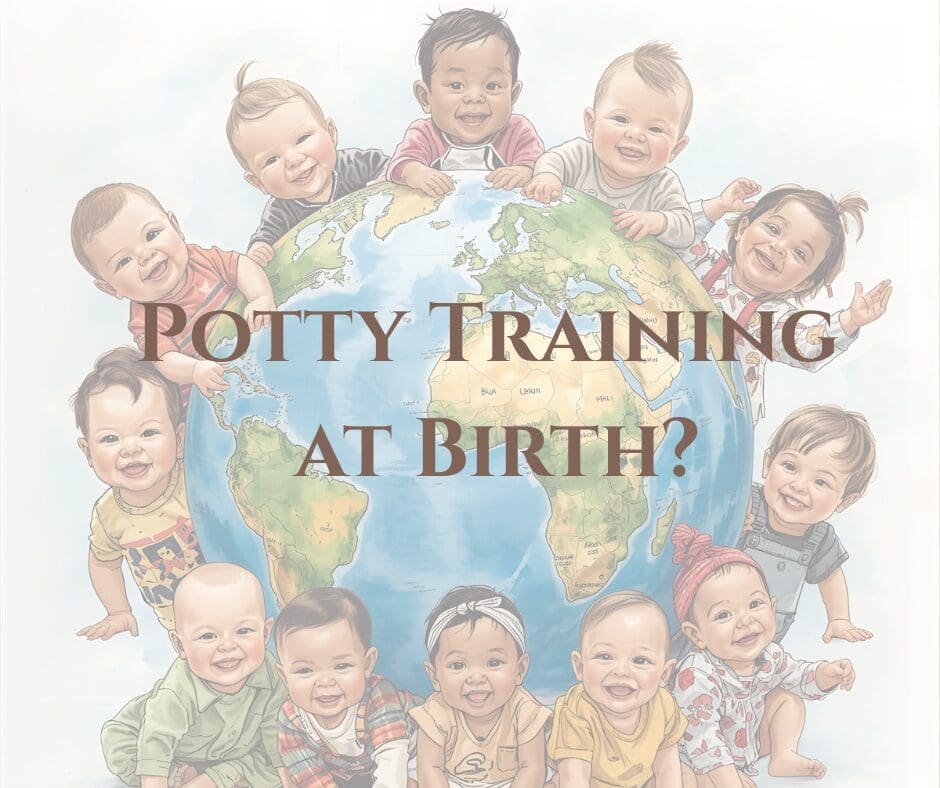In the U.S., we usually think of potty training as something that happens between ages two and three. It’s treated as a developmental milestone (something that comes after diapers, just like walking comes after crawling).
But that’s not the case everywhere. In many countries where diapers aren’t common or accessible, parents introduce the potty from the very beginning. The practice is called Elimination Communication (EC), and it flips the way we think about potty learning.
What Is Elimination Communication?
Instead of waiting for a toddler to “be ready,” parents who practice EC pay close attention to their baby’s cues (squirming, fussing, or shifting) and respond by holding them over a potty, toilet, or even outside. Over time, babies connect those sensations with elimination, just as they learn hunger cues and sleep rhythms.
It may sound new to us, but it’s actually the oldest way humans approached potty learning, long before disposable diapers were invented.
What We Can Learn from EC
Even if EC doesn’t fit your lifestyle, there are valuable lessons we can take from it:
- Body Awareness Comes Early
Babies are capable of sensing elimination needs earlier than we often assume. This relates to interoception (the awareness of what’s happening inside their bodies). - Communication Builds Connection
EC is really about communication between caregiver and child. Whether or not you use this method, watching for cues and responding consistently strengthens the parent-child bond. - Routine Creates Predictability
Just like mealtimes and bedtime, pottying can become a daily routine. The earlier children associate routine with elimination, the smoother the transition away from diapers often becomes.
How Diapers Changed the Way We Think About Potty Training
Before disposable diapers existed, elimination communication (or some version of it) was the norm. Mothers and caregivers simply didn’t have the option of putting babies in absorbent disposables for two or three years. Children learned body awareness earlier, and parents were tuned in to cues out of necessity.
But once disposable diapers became widespread in the mid-1900s, the cultural expectation shifted. Diaper companies marketed convenience and comfort, and in doing so, they extended the age of potty training. What used to be common by 18 months in many places stretched closer to 3 years in the U.S. (not because children changed, but because the diaper industry changed the messaging).
This doesn’t mean diapers are “bad” (they are undeniably convenient in a modern world), but it does mean we should question why we think potty training “has to” happen later. A lot of that belief comes from marketing, not biology.
What does this all mean?
Potty learning isn’t one-size-fits-all. What works in one family (or one country) may look completely different in another. But whether you’re using diapers, cloth, or EC, the underlying principle is the same: your child learns through consistency, communication, and connection.
So while most of us won’t toss out diapers tomorrow, we can take inspiration from other cultures: tune into our children’s cues, respect their body awareness, and approach potty training as a relationship, not just a milestone.
Click here to learn more about EC and how to do it successfully from Andrea Olson, a mom of 6 who has mastered this ancient strategy.
For more parenting tips and tricks go to Forgedbygrace.mom
Related Reading

View comments
+ Leave a comment